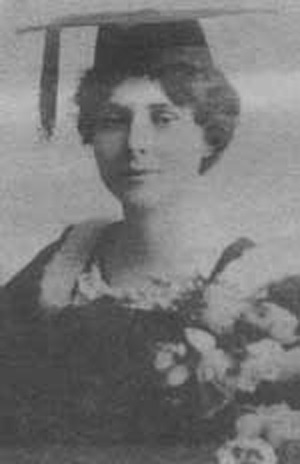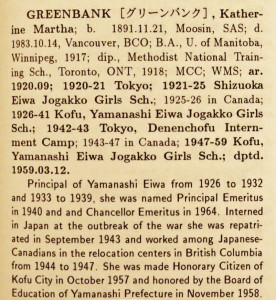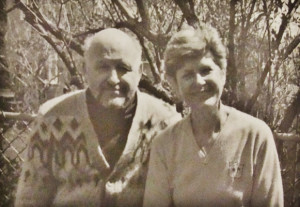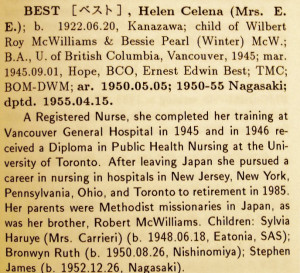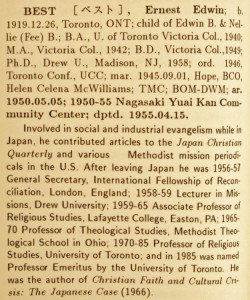Annie May McLachlan
May McLachlan was a teacher and principal at the Tashme high school. She was one of two – the other was Katherine Greenback – who were in Japan at the start of the war, and returned to Canada in August 1942 as part of the exchange of persons held in detention in Japan during the war.
Annie May McLachlan was born in Pipestone, Manitoba on November 3, 1895. She obtained a Bachelor of Arts degree from Brandon College in 1917, and served as Principal of Pipestone Intermediate School, then history teacher at Virden Collegiate in Manitoba, until 1922. In 1922, McLachlan enrolled in the United Church Training School in Toronto. When she finished her training in 1924, she was sent by the Woman’s Missionary Society to Japan. There she studied the Japanese language in Tokyo and worked as a teacher and missionary, primarily at private girls’ schools in Shizuoka and Kofu. During the Second World War, she was placed under house arrest in the city of Shizuoka, until she was returned to Canada in a Canadian and Japanese prisoner exchange in 1942.
McLachlan worked with the many Japanese Canadians interned at Tashme in British Columbia for the remainder of the war, teaching high school. After the war, she returned to Japan to work at the Shizuoka Eiwa Girls School. From about 1952, she began working for the church in Haibara. With her support, the church was able to sponsor an institution – Yamabato – homes for mentally disabled people.
In 1963, May retired and returned to Canada. She then began working among the people of the Soowahlie Reserve in Chilliwack, BC. One of her important accomplishments was organizing the Vedder Project, a project designed to help First Nations people receive a better education and to improve their access to health care and nutrition programs.
May McLachlan was presented with the Distinguished Service Award by the Alumni Association of Brandon University, in 1987; it was granted in recognition of her outstanding public service and contributions to society. She was posthumously awarded the Order of the Sacred Treasure by the Japanese government in June 1992. The medal honours individuals who have rendered exceptional service to the nation and the people of Japan. She died at her home in Chilliwack on October 13, 1991.
For audio and transcript of Interview with Ms McLachlan go to: www.bc.united-church.ca/content/annie-may-mclachlan
From BC Conference United Church of Canada
Katherine Greenbank
Katherine Greenbank was a teacher and principal at the Tashme high school. She was one of two, the other was May McLachlan, who were in Japan at the start of the war, and returned to Canada in September 1943 as part of the exchange of persons held in detention in Japan during the war.
From Directory of Methodist Missionaries to Japan, 1873-1993. Christianity and Culture Research Center, Research Institute of Aoyama Gakuin University, 1993
Ernest Edwin Best and Helen Best
Ernie Best was a highly-respected teacher at the high school in Tashme where he taught French. He is remembered as a caring person who was considered a 'conscientious objector' to military recruitment. He was recruited instead as a French teacher in the Tashme internment camp.
He married Helen Celena McWilliams, the daughter of Wilbert Roy McWilliams September 1, 1945 in Tashme.
From Directory of Methodist Missionaries to Japan, 1873-1993. Christianity and Culture Research Center, Research Institute of Aoyama Gakuin University, 1993
Winifred McBride Awmack
Winifred (McBride) Awmack was born in DePue, Illinois, in about 1918. Her father, a native of Scotland, was a metallurgist who had worked for several years in Mexico before moving to the United States.
After a few years in Illinois, the family moved to British Columbia. Winifred’s father worked in Victoria for a year and then was sent to Ladysmith to get a smelter there in running order. When the Depression hit, he lost his job but continued to keep the machinery in good condition and analyzed samples of mineral-bearing rocks.
Although Winifred’s father wanted her to go to university, the family could not afford the tuition. That meant that Winifred had to head her class each year in order to win the one scholarship available. She succeeded and graduated from the University of British Columbia in 1940 with a Bachelor’s degree in agriculture, majoring in plant pathology. She was unable to find work in her field because the only available job went to a man. For a while she worked for a firm that grew flowers for Spencer’s Store and others in Vancouver. Eventually, in October 1941, she got a job in the laboratory of the Canadian Fishing Company at the foot of Gore Street in Vancouver, doing Vitamin A analysis on fish oils made at the plant.
While at university, Winifred had joined the UBC Student Christian Movement, a group that held study groups and camps. In 1942 and 1943, she attended some of these camps, and it was there that she met an agriculture student named Joe Awmack, whom she would later marry. Joe, a conscientious objector, was doing alternative service instead of taking officer training, working in the woods under the Forest Service. At the camp, Winifred also met Ernie Best, another conscientious objector, who was working in the Forest Service as well.
In the fall of 1942, Reverend Wilbert Roy McWilliams, while serving the United Church congregation in the Tashme internment camp, was asked by his congregation for assistance in establishing a high school for the young people. He solicited the support of the church, helped organize the school and set out to find teachers for the school. Reverend McWilliams secured the release of three young men from the forestry camps to teach high school, one of whom was Ernie Best.
Joe Awmack returned to UBC in the fall of 1943, then visited Tashme at the end of the term and taught physics to grade nine and ten students. He later pronounced it one of the most interesting teaching assignments he ever had.
In the summer of 1944, Winifred moved to Six Mile near Hope, to be a leader at a camp for girls from Tashme run by May McLachlan of the United Church. The camp, at the site of an old logging camp, had tents for the campers and leaders, and a log building that served as kitchen, dining room and meeting place.
That summer, Helen McWilliams, Reverend McWilliams’s daughter, and Ernie Best came to see Winifred at the camp. They asked her to teach science at Tashme. Winifred had no teaching experience, but, she said, “I felt I could not say that I believed in the brotherhood of man and refuse this challenge.” On Labour Day weekend she collected all the science books she could find and reported to Tashme.
The Tashme High School had opened in January 1943 with funding from the United Church. By the time Winifred started teaching in the fall of 1944, the school had 90 grade 9 students, 40 grade 10 students, 30 grade 11 students and 15 to 20 grade 12 students. The staff consisted of four teachers: Winifred; May McLachlan, who had started the school with Doug Saunders of the B.C. Security Commission; Katherine Greenbank, principal from 1944 to 1946; and Jim Williams, who had replaced Ernie Best after he returned to university.
Winifred taught all the science and health classes, plus grade 9 math and one class of grade 10 math. At first, she reported, she had trouble keeping order in the classroom: the students didn’t pay attention. When she asked them why, they gave her three reasons: they couldn’t always hear her because of the configuration of the room; the scientific vocabulary she used was too advanced; and, as one student put it, “It’s against human nature to sit in pairs and not talk.” Winifred made adjustments and had no more trouble after that.
Winifred’s religious conviction came slowly and deliberately. At the age of 12, when her Sunday school teacher said that the miracles in the Bible were literal, Winifred, with her scientific mind, had trouble believing it. She decided that someone had written the New Testament so that people would be good. By the time she went to Tashme, she vaguely believed that there was a power greater than humans in the universe, but had no formed theology.
At Tashme, the staff ate meals, read philosophical texts and the Bible, and prayed together. At first she resisted, but came to feel that prayer was a comfort, that it brought joy and united the staff.
In 1946, Winifred went to Toronto to train for the Women’s Missionary Society of the United Church, and the following year she went to Montreal to work for the Women’s Missionary Society at St. Columba House, a church and community centre.
In August 1948, Winifred visited Joe Awmack in Golden, where he was district agriculturalist. They married on October 30, 1948, in a Quaker ceremony. The couple had six children and lived in Cranbrook for 20 years. They moved to Victoria in 1967 so Joe could head up the committee to oversee the building of the Indian Museum and training center of 'Ksan near Hazelton.
In 1993, Winifred published Tashme - A Japanese Relocation Centre, 1942-1946, which describes the camp, the school and the impact the United Church staff had on the community of young adults in Tashme.
Hawkins, Frances Belle, 1891-1978
Frances Belle Hawkins was one of several Anglican Church of Canada missionaries who taught kindergarten in Tashme.
Ms Hawkins was born on Oct 6, 1891 in Meaford Ontario Canada. After graduating from Meaford High School, she enrolled in Anglican Women’s Training College in Toronto, graduating as a Deaconess in 1920. She immediately traveled to Japan to work in kindergarten education at Toyohashi, Nagoya, Okaya. During a sabbatical from her work there, she completed a Kindergarten course at the Toronto Normal School in 1926 and returned to Nagoya.
In Jan 1940, Ms Hawkins was appointed as the principal of The Ryujo Kindergarten Teachers' Training School. Later in the same year, the Bishop, Shinji Sasaki, ordered her to evacuate to Canada before the outbreak of war in the Pacific. Initially, she refused to leave Japan because she wanted to continue her work for Japanese children and students. But at last she returned to Hamilton Ontario Canada in Apr 1941.
Back in Canada she immediately volunteered to work with the Japanese in BC and was first sent to Port Alberni where she witnessed the forced removal of local Japanese first to Hastings Park then to internment camps. She followed the displaced Japanese to Hastings Park, then to Tashme where she helped establish a kindergarten and taught there. When the Tashme internment camp was closed in July 1946, she returned to Hamilton.
In 1947, she left for Japan and in Apr 1948 she was appointed as the third principal of The Ryujo Kindergarten Teachers Training School and in 1953 became the first president of Ryujo College when it was accredited as a college. She retired at age 70 and returned to Hamilton in Jun 1961.
In 1972 the Woman’s Auxiliary of the Anglican Church of Canada conducted a survey about the church work that women had done in Canada and Overseas. Frances Hawkins responded to the request and wrote about her work with the Japanese both in Japan and in Canada.
About her time at Tashme, BC Miss Hawkins wrote:
Came back to Canada in 1941, and after a short furlough, was sent with Miss Horobin to work with the Japanese in Port Alberni, B.C. where after Pearl Harbour, we were about their only friends. The men were sent off to work camps on the mainland, and we stayed with the women and children till they were evacuated to Hastings Park, Vancouver. While they were there, we had kindergarten and Sunday meetings for them and as they were sent inland, went along. Miss Walker, Miss Bailey and I went to Tashme, the nearest camp to Vancouver. Rev. W.H. Gale was in charge and for a time we had to go up with him each week-end. Afterwards we were given living accommodation, and a place for kindergarten and church use, and continued there for 4 ½ years.
Ms Hawkins died on Nov 26 1978 in Hamilton Ontario
Contribution to this biography from Ms Junko Hakane of Nagoya Japan is acknowledged.
